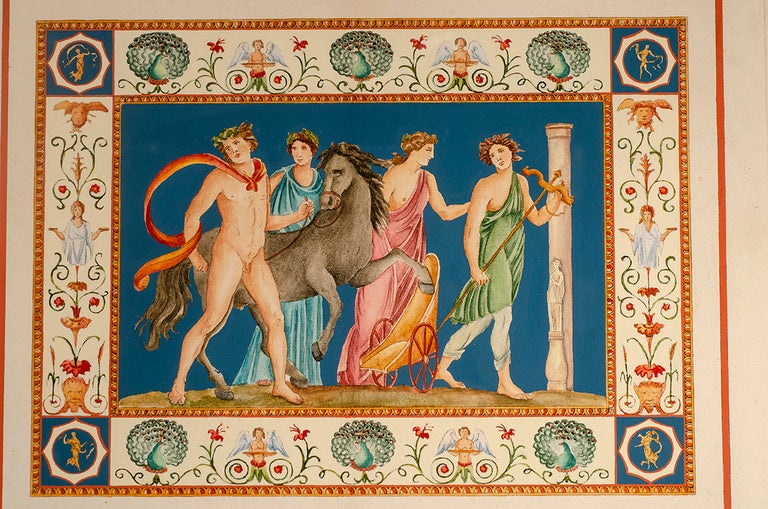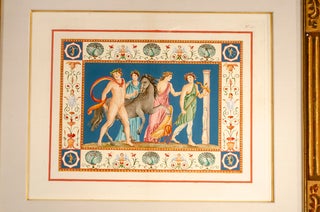Domus Aureus. Plate # 15.
Rome: Ludovico Mirri, 1776-1778. Item #05030
Emperor Nero's Golden Palace
The Domus Aureus
CARLONI, Marco (1742-1796) after SMUGLIEWICZ, Franciszek (1745-1807) and BRENNA, Vincenzo (1745-1820). Detail of a fresco in the 'Domus Aureus'. Rome: Ludovico Mirri, [1776-1778].
Plate # 16. Original engraving with later hand coloring. Fine in a stunning gilt frame. Framed size: (28 x 23 3/4 inches; 711 x 603 mm.). Plate mark: (18 1/4 x 14 1/8 inches; 463 x 359 mm.). A fine plate from 'Vestigia delle terme di Tito e loro interne pitture' of an ancient fresco from the 'Domus Aureus', Nero's sumptuous imperial complex in Rome.
A spectacular plate from 'Vestigia delle terme di Tito e loro interne pitture' of an ancient fresco from the 'Domus Aureus', Nero's sumptuous imperial complex in Rome. The image depicts three women, a naked man and a prancing horse. The women are dressed in blue, red and green robes, one of them standing by a child's chariot. The image is surrounded by a wonderful decorative border.
The Domus Aurea (Latin, "Golden House") was a vast landscaped palace built by the Emperor Nero in the heart of ancient Rome after the great fire in 64 AD had destroyed a large part of the city and the aristocratic villas on the Palatine and Esquiline Hills. It replaced and extended his Domus Transitoria that he had built as his first palace complex on the site.
Carloni's beautifully rendered plates faithfully capture the grotesque style of the ancient frescoes, which was characterized by decorative borders filled with whimsical, often comical animals and foliage taken from both nature and the artist's imagination. The ornamental borders also served the practical functions of framing the central mythological, religious, or historical subject portrayed and separating the various murals in a single decorative scheme.
Designed by architects Severus and Celer. The magnitude and decadent extravagance of the impressive gold-covered, jewel bedecked palace was intended to glorify the Emperor's reign. Its rooms were filled with lavish furniture and its walls and ceilings covered with decorative late-Hellenistic murals by the renowned ancient artist Fabullus. Nero, however, died in 68 AD before the Domus was totally completed. In 1480, practically forgotten, the Domus was excavated, and its subterranean passages and rooms thereafter became known as 'le grotte' (cave). Many of its original frescoes survived, and their motifs and ancient style of ornamentation, called 'grotteschi' (grotesque) after 'grotte', became extremely popular during the Renaissance, influencing many prominent artists such as Raphael, Michelangelo, Ghirlandio, and Pinturicchio. Published in 1776, 'Vestigia delle terme di Tito e loro interne pitture' is an elaborate album of engravings depicting the stunning 'al fresco' and 'al stucco' murals of Nero's Domus Aureus. Carloni's beautifully rendered plates faithfully capture the ancient Roman grotesque style, which became a hallmark of Renaissance Art.
https://archive.org/details/gri_33125008626216/page/53/mode/2up.
Price: $1,750.00

 I have been in the rare and antiquarian book business for over forty years; my family has been in the rare books business since 1876. Rare books are in my blood.
I have been in the rare and antiquarian book business for over forty years; my family has been in the rare books business since 1876. Rare books are in my blood.

